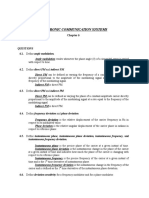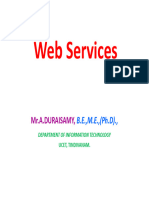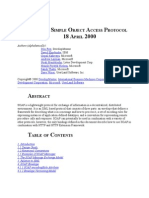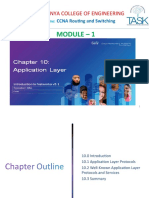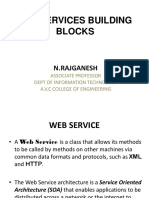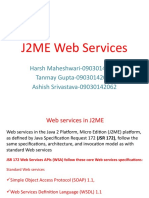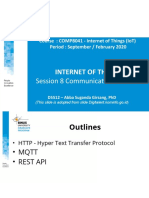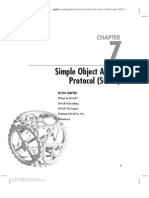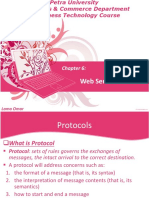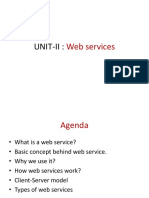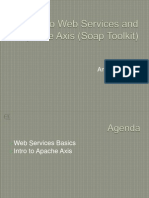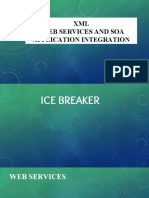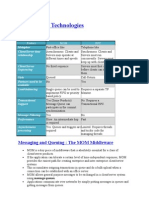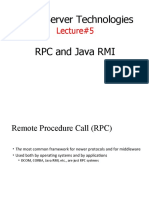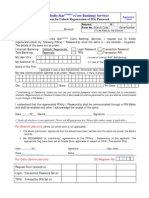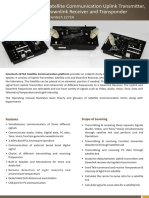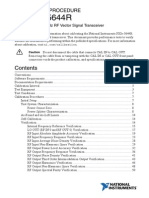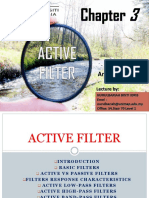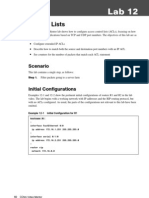0 ratings0% found this document useful (0 votes)
49 viewsSimple Object Access Protocol
Simple Object Access Protocol
Uploaded by
Sathyan RvksSOAP is an XML-based messaging protocol for exchanging information between systems over a network. It allows systems to communicate regardless of programming language or operating system. SOAP uses XML and other open standards to encode requests and responses. A SOAP message contains an Envelope with an optional Header and a required Body. The Body contains the call and response information. Namespaces are used to distinguish elements from different sources and resolve naming collisions.
Copyright:
© All Rights Reserved
Available Formats
Download as PPTX, PDF, TXT or read online from Scribd
Simple Object Access Protocol
Simple Object Access Protocol
Uploaded by
Sathyan Rvks0 ratings0% found this document useful (0 votes)
49 views13 pagesSOAP is an XML-based messaging protocol for exchanging information between systems over a network. It allows systems to communicate regardless of programming language or operating system. SOAP uses XML and other open standards to encode requests and responses. A SOAP message contains an Envelope with an optional Header and a required Body. The Body contains the call and response information. Namespaces are used to distinguish elements from different sources and resolve naming collisions.
Original Description:
xml
Original Title
Soap
Copyright
© © All Rights Reserved
Available Formats
PPTX, PDF, TXT or read online from Scribd
Share this document
Did you find this document useful?
Is this content inappropriate?
SOAP is an XML-based messaging protocol for exchanging information between systems over a network. It allows systems to communicate regardless of programming language or operating system. SOAP uses XML and other open standards to encode requests and responses. A SOAP message contains an Envelope with an optional Header and a required Body. The Body contains the call and response information. Namespaces are used to distinguish elements from different sources and resolve naming collisions.
Copyright:
© All Rights Reserved
Available Formats
Download as PPTX, PDF, TXT or read online from Scribd
Download as pptx, pdf, or txt
0 ratings0% found this document useful (0 votes)
49 views13 pagesSimple Object Access Protocol
Simple Object Access Protocol
Uploaded by
Sathyan RvksSOAP is an XML-based messaging protocol for exchanging information between systems over a network. It allows systems to communicate regardless of programming language or operating system. SOAP uses XML and other open standards to encode requests and responses. A SOAP message contains an Envelope with an optional Header and a required Body. The Body contains the call and response information. Namespaces are used to distinguish elements from different sources and resolve naming collisions.
Copyright:
© All Rights Reserved
Available Formats
Download as PPTX, PDF, TXT or read online from Scribd
Download as pptx, pdf, or txt
You are on page 1of 13
Simple Object Access Protocol
• SOAP is an XML-based messaging and remote procedure
call (RPC) specification that enables the exchange of
information among distributed systems
• SOAP has achieved its level of widespread acceptance
for several reasons:
• open specification, available for anyone to use
• simple to write and is “human-readable.”
• extensible, taking advantage of the power of XML to
enable loose coupling between remote systems
• flexible protocol that is useful both in request/response
and message passing/queuing architectures
Introduction to SOAP
• SOAP is a standard way of serializing the information
needed to invoke services located on remote systems
• the information can be sent over a network to the
remote system, in a format the remote system can
understand, regardless of what platform the remote
service runs on or what language it’s written in
• SOAP resembles the wire protocols underlying both
architectures:
– the Internet Inter-ORB Protocol (IIOP) that underlies
CORBA
– Microsoft’s Distributed Component Object Model (DCOM)
protocol
Introduction to SOAP
• With message passing, a message sender can
send a message at any time, and the
messaging infrastructure is responsible for
delivering the message - asynchronous
message delivery
• With the request/response model, the
message sender typically must wait until it
receives a response from the recipient –
synchronous message delivery
Introduction to SOAP
• Object RPC (ORPC) protocols such as CORBA’s
IIOP and DCOM became dominant in the
distributed computing arena
• CORBA/IIOP and DCOM have several problems
– CORBA and DCOM are single-vendor solutions
– CORBA and DCOM have different, proprietary
characteristics - CORBA’s payload parameter value
format is the Common Data Representation (CDR),
whereas DCOM’s is the incompatible Network Data
Representation (NDR)
– CORBA uses Interoperable Object References (IORs)
for endpoint naming, whereas DCOM uses OBJREFs
Introduction to SOAP
• SOAP addresses drawbacks to existing ORPC
architectures:
• SOAP is built with open technologies and is an open
specification - SOAP is a vendor-neutral protocol
• SOAP uses XML as its payload parameter value format
and uses URIs
• SOAP interfaces are described with the Web Services
Description Language WSDL
• SOAP is based on XML, it is a text-based protocol -
simpler than CORBA and DCOM
• SOAP messages are human-readable and firewall -
SOAP is a loosely coupled protocol
Key Building Block for Web Services
• SOAP provides three key capabilities:
– SOAP is a messaging framework, consisting of an
outer Envelope element that contains an optional
Header element and a mandatory Body element
– SOAP is an encoding format that describes how
objects are encoded, serialized, and then decoded
when received.
– SOAP is an RPC mechanism that enables objects to
call methods of remote objects
SOAP Message Structure and
Namespaces
• simple example of a message -to send a request
to the server for a person’s phone number
• client sends an XML-formatted request to the
server
– <?xml version=”1.0”?>
– <PhoneNumber>
– <getPhoneNumber>
– <name>John Doe</name>
– </getPhoneNumber>
– </PhoneNumber>
SOAP Message Structure and
Namespaces
• use client to create an HTTP request, and put the
preceding XML in the body of an HTTP POST
• a response from the server will be of the form :
– <?xml version=”1.0”?>
– <PhoneNumber>
– <getPhoneNumberResponse>
– <thenumber>
– <areacode>617</areacode>
– <numberbody>555-1234</numberbody>
– </thenumber>
– </getPhoneNumberResponse>
– </PhoneNumber>
SOAP Message Structure and
Namespaces
• The root node retains the name of the interface, but
the method name has the word “Response” appended
to it, so the client can identify the correct response by
appending “Response” to the calling method name
• limitation is that the vocabulary that the client and
server use to exchange messages must be agreed
• If there is a new method or a new parameter, both the
client and the server must reprogram their interfaces.
• In a complex message, there could be a confusion if
two methods have parameters with the same name
• To resolve these limitations with such simple message
formats, SOAP takes advantage of XML namespaces
SOAP Message Structure and
Namespaces
• the same request message recast in SOAP:
• <SOAP-ENV:Envelope xmlns: SOAP-ENV=
“http://schemas.xmlsoap.org/soap/envelope/”
• xmlns:xsi=”http://www.w3.org/1999/XMLSchema-instance”
• xmlns:xsd=”http://www.w3.org/1999/XMLSchema”
• SOAP-ENV:encodingStyle=”http://schemas.xmlsoap.org/soap/encoding/”>
• <SOAP-ENV:Header>
• </SOAP-ENV:Header>
• <SOAP-ENV:Body>
– <ns:getPhoneNumber xmlns:ns=“PhoneNumber”>
– <name xsi:type=“xsd:string”>John Doe</name>
– </ns:getPhoneNumber>
• </SOAP-ENV:Body>
• </SOAP-ENV:Envelope>
SOAP Message Structure and
Namespaces
• root node is Envelope - has an optional
Header section and a mandatory Body section
• SOAP Envelope is then enclosed in the outer
transport envelope, which might be HTTP,
SMTP
• SOAP messages are structured like this
SOAP Message Structure and
Namespaces
• There are two forms of namespace declarations:
– default declarations and explicit declarations
• Explicit declarations are of the form:
– xmlns:SOAP-ENV=http://schemas.xmlsoap.org/soap/envelope/
• The default declarations : xmlns=”SomeURI”
• Explicit declarations begin with the xmlns keyword, followed by a
colon and a shorthand designation for the namespace.
• The SOAP-ENV namespace includes the <Envelope>,<Header>, and
<Body> structural elements
• the encodingStyle attribute-
http://schemas.xmlsoap.org/soap/envelope/ - is the standard URL
for the SOAP-ENV namespace
• explicit declaration is used for a publicly available namespace-
default declarations are appropriate for custom namespaces
SOAP Message Structure and
Namespaces
• server’s response message:
• <SOAP-ENV:Envelope xmlns:SOAP-
ENV=”http://schemas.xmlsoap.org/soap/envelope/”
• xmlns:xsi=”http://www.w3.org/1999/XMLSchema-instance”
• xmlns:xsd=”http://www.w3.org/1999/XMLSchema”
• SOAP-ENV:encodingStyle=”http://schemas.xmlsoap.org/soap/encoding/”>
• <SOAP-ENV:Body>
– <getPhoneNumberResponse xmlns=”SomeURI”>
– <areacode>617</areacode>
– <numberbody>555-1234</numberbody>
– </getPhoneNumberResponse>
• </SOAP-ENV:Body>
• </SOAP-ENV:Envelope>
• The response message shows an example of a namespace with a default
declaration <getPhoneNumberResponse xmlns=”SomeURI”>
You might also like
- AMBA AXI Protocol Interview Questions - Xilinx, Sicon, Ensilica and MobiveilDocument2 pagesAMBA AXI Protocol Interview Questions - Xilinx, Sicon, Ensilica and MobiveilVIKRAM100% (5)
- Chapter 7Document16 pagesChapter 7YvesExequielPascua100% (2)
- Lecture 6 ICT 723 - SplitDocument31 pagesLecture 6 ICT 723 - SplitIIB TechNo ratings yet
- Introduction To Web Services: S.SasirekhaDocument33 pagesIntroduction To Web Services: S.SasirekhaAnonymous 1pDnp6XZNo ratings yet
- Introduction To SOAP: Scott D. StollerDocument6 pagesIntroduction To SOAP: Scott D. Stollerrkmfc24No ratings yet
- xml unit 3Document42 pagesxml unit 32313323037015No ratings yet
- Soap MsgsDocument7 pagesSoap MsgsFaizan HyderNo ratings yet
- 3.01 Client-Server Architecture and Communication ProtocolsDocument32 pages3.01 Client-Server Architecture and Communication ProtocolsSerge KushnerNo ratings yet
- Web Services - Sudhanshu Shekhar PDFDocument15 pagesWeb Services - Sudhanshu Shekhar PDFSudhanshuNo ratings yet
- System Integration Chapter 4-Web Service Technologies: Soap WSDL UddiDocument26 pagesSystem Integration Chapter 4-Web Service Technologies: Soap WSDL Udditeddy demissieNo ratings yet
- Web ServicesDocument33 pagesWeb Servicesjanaranjani.k100% (1)
- Larry Gillis Eric Lam Cindy Lee Calvin Nguyen Evgeni ZlatanovDocument19 pagesLarry Gillis Eric Lam Cindy Lee Calvin Nguyen Evgeni Zlatanovst57143No ratings yet
- 12-Web ServicesDocument20 pages12-Web ServicesDanial KayaniNo ratings yet
- Notes For ADBMSDocument49 pagesNotes For ADBMSSwatiNo ratings yet
- SOAP pt1Document6 pagesSOAP pt1Suganya MasilamaniNo ratings yet
- 5 3 Web Services SOAP UDDI WSDL (Compatibility Mode)Document98 pages5 3 Web Services SOAP UDDI WSDL (Compatibility Mode)prakash SNo ratings yet
- WebServices SIAwebsiteDocument28 pagesWebServices SIAwebsiteFaiza RasheedNo ratings yet
- Soa 101Document55 pagesSoa 101Naresh GoudNo ratings yet
- SOAP MessageDocument40 pagesSOAP Messagemskr_scribdNo ratings yet
- Slides 10 WebServicesDocument38 pagesSlides 10 WebServicesudithaNo ratings yet
- Chapter - 10Document36 pagesChapter - 10Sindhu official radhakrishnNo ratings yet
- 4 - Communication - Part 1Document21 pages4 - Communication - Part 1Malek MsadekNo ratings yet
- Unit4 - Application LayerDocument41 pagesUnit4 - Application Layersriyogesh223No ratings yet
- Webservices Building Blocks: N.RajganeshDocument29 pagesWebservices Building Blocks: N.RajganeshxxxNo ratings yet
- Client ServerDocument24 pagesClient ServerAkrati GuptaNo ratings yet
- J2ME Web Services: Harsh Maheshwari-09030142071 Tanmay Gupta-09030142066 Ashish Srivastava-09030142062Document15 pagesJ2ME Web Services: Harsh Maheshwari-09030142071 Tanmay Gupta-09030142066 Ashish Srivastava-09030142062anon_232573No ratings yet
- Unit 6 MWADocument23 pagesUnit 6 MWAwaghuletanishNo ratings yet
- Group IV - SoapDocument25 pagesGroup IV - SoapBryan William CabigtingNo ratings yet
- Communication ProtocolDocument63 pagesCommunication ProtocolRusnandi FikriNo ratings yet
- Module 2DSDocument51 pagesModule 2DSchinmayavaishnaviNo ratings yet
- Simple Object Access Protocol (SOAP) : in This ChapterDocument34 pagesSimple Object Access Protocol (SOAP) : in This ChapterSuraj JathannaNo ratings yet
- High Powered Messaging With: James Carr Software Engineer OCIDocument37 pagesHigh Powered Messaging With: James Carr Software Engineer OCINgô Ngọc ThànhNo ratings yet
- Chapter 11 - Application LayerDocument35 pagesChapter 11 - Application Layernguyenphuctan30No ratings yet
- Remote Procedure Call (RPC)Document22 pagesRemote Procedure Call (RPC)shanakaijtsNo ratings yet
- Web Service Stack: Lama OmarDocument11 pagesWeb Service Stack: Lama OmarAnonymous SIciJgNo ratings yet
- A Restful Approach: Clean Upnp Without SoapDocument6 pagesA Restful Approach: Clean Upnp Without Soapm.banduNo ratings yet
- Web System & Technologies NotesDocument15 pagesWeb System & Technologies Notestanzilalatif143No ratings yet
- Web ServicesDocument69 pagesWeb ServicesMisbah ShareefNo ratings yet
- Intro To Apache AxisDocument45 pagesIntro To Apache AxisAnkur B. RoyNo ratings yet
- Siam7 PDFDocument22 pagesSiam7 PDFCherry Mea BahoyNo ratings yet
- Applications:Electronic Mail (SMTP, Pop, Imap, Mime) : Presented By-Tarun Lall Badrinath Sai Kumar PraveenDocument28 pagesApplications:Electronic Mail (SMTP, Pop, Imap, Mime) : Presented By-Tarun Lall Badrinath Sai Kumar PraveenkdhanamjayNo ratings yet
- Web TechnologyDocument247 pagesWeb TechnologydineshkumarhclNo ratings yet
- CS 253 NotesDocument2 pagesCS 253 NotesAlicia ColemanNo ratings yet
- WCF1Document32 pagesWCF1shubhangiNo ratings yet
- Simple Object Access ProtocolDocument38 pagesSimple Object Access Protocolnikky72No ratings yet
- Application Layer: Presented By: Sanskrati Upadhyay Roll Number: MT19CPS018Document29 pagesApplication Layer: Presented By: Sanskrati Upadhyay Roll Number: MT19CPS018Vishal Raj (MT19CPS020)No ratings yet
- Middleware Technologies Unit-IDocument14 pagesMiddleware Technologies Unit-IannamyemNo ratings yet
- Distributed Systems: Lecture #1: Remote CommunicationDocument20 pagesDistributed Systems: Lecture #1: Remote CommunicationWa Ode MuslimahNo ratings yet
- Using Web Services in The European Grid of Solar Observations (EGSO)Document12 pagesUsing Web Services in The European Grid of Solar Observations (EGSO)Uday KumarNo ratings yet
- 5.4 Marshalling in Distributed SystemDocument13 pages5.4 Marshalling in Distributed SystemHamsitha ChoudharyNo ratings yet
- The World Wide Web: Outline Background Structure ProtocolsDocument18 pagesThe World Wide Web: Outline Background Structure ProtocolsKelsiSivaNo ratings yet
- Lecture 3Document42 pagesLecture 3Hassan allaNo ratings yet
- What You Should Already Know: Home PageDocument18 pagesWhat You Should Already Know: Home PagesvgayetruNo ratings yet
- XML Soap1Document17 pagesXML Soap1Amarech5No ratings yet
- SOAP: Simple Object Access Protocol: Mike P. Papazoglou Mikep@uvt - NLDocument28 pagesSOAP: Simple Object Access Protocol: Mike P. Papazoglou Mikep@uvt - NLrahulsv1No ratings yet
- WebservicesDocument22 pagesWebservicesKashan AsimNo ratings yet
- Client/Server Technologies RPC and Java RMI: Lecture#5Document32 pagesClient/Server Technologies RPC and Java RMI: Lecture#5Iqra KhanNo ratings yet
- Some Imp Points Sla IntegrationDocument6 pagesSome Imp Points Sla IntegrationMayuresh YadavNo ratings yet
- Web ServicesDocument22 pagesWeb ServicesMahamud elmogeNo ratings yet
- Distributed Systems Programming Sockets: On TCP/IP NetworksDocument7 pagesDistributed Systems Programming Sockets: On TCP/IP NetworksJitendra Singh RauthanNo ratings yet
- Evaluation of Some SMTP Testing, SSL Checkers, Email Delivery, Email Forwarding and WP Email Tools: Evaluation of Some SMTP Testing, SSL Checkers, Email Delivery, Email Forwarding and WordPress Email ToolsFrom EverandEvaluation of Some SMTP Testing, SSL Checkers, Email Delivery, Email Forwarding and WP Email Tools: Evaluation of Some SMTP Testing, SSL Checkers, Email Delivery, Email Forwarding and WordPress Email ToolsNo ratings yet
- Evaluation of Some SMTP Testing, Email Verification, Header Analysis, SSL Checkers, Email Delivery, Email Forwarding and WordPress Email ToolsFrom EverandEvaluation of Some SMTP Testing, Email Verification, Header Analysis, SSL Checkers, Email Delivery, Email Forwarding and WordPress Email ToolsNo ratings yet
- EXTRANETDocument21 pagesEXTRANETVATSAL CHANGOIWALANo ratings yet
- Digitally Controlled Envelope Tracking Power Supply For An RF Power AmplifierDocument7 pagesDigitally Controlled Envelope Tracking Power Supply For An RF Power AmplifierHamed GheidiNo ratings yet
- Star Connect Unblock or Regeneration FormDocument1 pageStar Connect Unblock or Regeneration FormsatpalkakkadNo ratings yet
- Satellite Communication Uplink Transmitter Downlink Receiver and TransponderDocument2 pagesSatellite Communication Uplink Transmitter Downlink Receiver and TransponderTHONTARADYA CHANNELNo ratings yet
- TTB-709016-172718-172718DER-65Fv01 (MTS46)Document2 pagesTTB-709016-172718-172718DER-65Fv01 (MTS46)yevobimNo ratings yet
- IMEI DocsDocument2 pagesIMEI DocsVikas NigamNo ratings yet
- Ieee 1588Document5 pagesIeee 1588raghavendran raghuNo ratings yet
- Communication Protocol X-Line V3.7Document38 pagesCommunication Protocol X-Line V3.7cesarjaramilloudeNo ratings yet
- CS2060 - High Speed Networks Question Bank PDFDocument12 pagesCS2060 - High Speed Networks Question Bank PDFVive Kowsal YanissNo ratings yet
- Advantages & Disadvantages of UCaaSDocument6 pagesAdvantages & Disadvantages of UCaaSBabar SaeedNo ratings yet
- Genius: High Accuracy Three Phase Smart MeterDocument2 pagesGenius: High Accuracy Three Phase Smart Meterkaviraj cebNo ratings yet
- Alcatel 9400AWYDocument2 pagesAlcatel 9400AWYMohamed MoungaNo ratings yet
- Graduate Diploma in Cultural Education: (To Be Accomplished Individually by Nominated Participant Email To:)Document2 pagesGraduate Diploma in Cultural Education: (To Be Accomplished Individually by Nominated Participant Email To:)Ralph Christian CurrimaoNo ratings yet
- Online Test Question Along With ExplainationDocument18 pagesOnline Test Question Along With ExplainationRaj kapish GuptaNo ratings yet
- Chapter 4 (Link Calculation)Document17 pagesChapter 4 (Link Calculation)nicoleNo ratings yet
- Resume For Ece StudentsDocument9 pagesResume For Ece Studentsf60pk9dc100% (2)
- 110 28702-Kre10124121Document3 pages110 28702-Kre10124121Justus VictorNo ratings yet
- Telefono SDocument114 pagesTelefono SROLANDONo ratings yet
- Cisco Model DPC2203 Cable Modem With Embedded MTA: Data SheetDocument16 pagesCisco Model DPC2203 Cable Modem With Embedded MTA: Data SheetMuhammad Tanveer AnjumNo ratings yet
- Summary Bill Feb 2024Document6 pagesSummary Bill Feb 2024qf6n45q5mw100% (2)
- Line CodingDocument15 pagesLine CodingjugulkNo ratings yet
- Marvell Automotive Ethernet 88q211x Product BriefDocument2 pagesMarvell Automotive Ethernet 88q211x Product BriefArun KumarNo ratings yet
- Pxie5644r CalibrationDocument67 pagesPxie5644r Calibrationcisco211No ratings yet
- Computer StudiesDocument17 pagesComputer StudiesMJAY GRAPHICSNo ratings yet
- Achieving Frequency Reuse 1 in Wimax Networks With BeamformingDocument14 pagesAchieving Frequency Reuse 1 in Wimax Networks With Beamformingbulli babuNo ratings yet
- Study On Customers SatisfactionDocument4 pagesStudy On Customers SatisfactionRenjitha ViswanathNo ratings yet
- CH 3 - Active FilterDocument84 pagesCH 3 - Active FilterNURUL NADHIRAH ROSDINo ratings yet
- CVM Lab 12Document4 pagesCVM Lab 12AdedayoNo ratings yet

